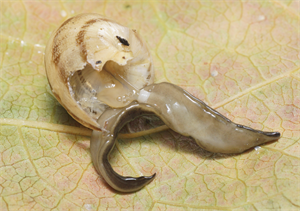- Worldwide distribution. In Oceania, in many Pacific island countries from lowlands to 3500 m. It predates slugs, snails, earthworms, insects. One of the worse 100 invasive pests.
- Damage: a generalist; reduced local snail diversity where introduced to control giant African snails. A host of the rat lung worm.
- Prefers moist disturbed areas - forests, plantations, orchards. Lives in leaf litter, under rocks, timber. Reproduces sexually. Up to 60 mm long, flat, tapering from middle with central stripe and pale belly.
- Spread: mobile, and via domestic and international trade in plants.
- Biosecurity: Countries free from the flatworm, (i) avoid introductions to control giant African snail and (ii) regulate movement of plants, soil and products likely to harbour flatworms, across national borders. Ensure plant introduction use soil-less compost or are bare-rooted cuttings. If soil necessary, enclose plant and soil in plastic bag and immerse in water, 43°C for 5 minutes.
- Cultural control: make baits enclosing snails in 2 mm nylon bags; kill flatworms using boiling water.
- Chemical control: none recommended.





